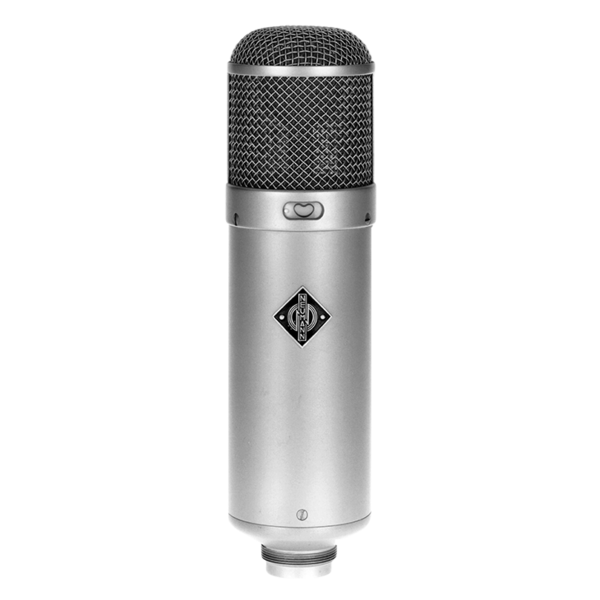The U 47, introduced in 1949, was a technical revolution and is still considered the indisputable reference for perfect sound. With its well-balanced, extremely vivid response and excellent low-noise performance, this tube microphone raised the bar to a whole new level. Although production had to be discontinued in 1965, the U 47 has remained an extremely sought-after studio microphone that no world-class studio should be without.
Zero Hour
The U 47 is the first Neumann microphone developed after the Second World War. Instead of reissuing pre-war models, Georg Neumann decided to make a fresh start, as tube technology in particular had made enormous progress. This meant that the housing could be designed relatively compact – by the standards of the time. Electronic polar pattern switching between cardioid and omnidirectional was a complete novelty. Swapping capsule heads was no longer necessary, and the capsule could be integrated into the microphone housing. This was the birth of the modern studio microphone.
Larger than Life
The transducer chosen for the U 47 was the M7 dual diaphragm condenser capsule, which had already been developed back in the 1930s. Originally it was offered as a cardioid option for the “Neumann Bottle” CMV 3. But just how far ahead of its time this sophisticated large diaphragm capsule was, could not be heard until it was used in the U 47, which brought it to full fruition. In addition to making the polar pattern switchable, the technical perfection of the U 47’s tube circuitry was also revolutionary. It is the interplay or all components that results in a an unparalleled magic of sound: The U 47 adds a noble sheen to voices and instruments that often makes the recorded sound even more beautiful and “larger” than the sound source itself.
Technical Perfection
What is often overlooked beyond this sonic magic is the underlying technical perfection. Yet it forms the basis for the U 47's ability to captivate us to this day. As early as the late 1940s, the U 47 achieved a signal-to-noise ratio that is beyond reproach, even today. An important factor in this was the mythical VF 14 tube. Contrary to common belief, it was not a receiver tube for old “Volksempfänger” radios or even a "surplus military tube”. Quite the opposite: The VF 14, introduced by Telefunken only in 1947, was a comparatively expensive “special request” tube. One of its unique features was an unusually high heater voltage, which made it possible to operate the U 47 with only one voltage that could be used for both the heater and the anode supply. This simplified potential battery operation and allowed long cable runs without readjusting the heater voltage. The longevity of the VF 14 tube is also legendary. In many U 47 microphones, the same tube has been in service for decades.
Telefunken not only manufactured the tube. In the USA and several other countries, the giant corporation also acted as a distributor for Neumann products. In the process, the Neumann badge was replaced by the Telefunken logo, which is why some associate the U 47 with Telefunken. In fact, all historic U 47 microphones were developed and manufactured by Neumann.
Evolution
Over the years, some details were improved. Towards the end of the 1950s, the housing could be shortened by 23 mm to make the U 47 a bit more compact. Which is why U 47 connoisseurs talk about “long body” and “short body” versions – apart from cosmetics, both are identical. Around the same time, the basket changed from polished nickel to satin nickel, which was advantageous for film and TV use in order to avoid light reflections. Towards the End of the 1950s, the M7 capsule was replaced by the K 47. This was a re-engineered version using same capsule acoustics. A major advantage of the K 47 capsule is the use of time-stable polyester diaphragms instead of the previously used PVC material, which became brittle over the years. Sonically, both capsule variants are very similar.
In 1957, the U 48 was introduced as a model variant that could be switched between cardioid and figure-of-eight patterns. Otherwise, it was largely identical (apart from a slightly lower polarization voltage). The famous U 47 Frank Sinatra used to record most of his classics at Capitol Studio is actually a U 48 – which continues to be used extensively.
The Myth Persists
Ultimately, the legend of the U 47 defies any attempt at explanation. Myths surround each of its components: from the M7/K 47 capsule to the VF 14 tube, the BV 08 transformer to the MP capacitors. And yet the U 47 is more than the sum of its parts. It is the perfect interplay of all of its components as well as the hard work of Neumann engineers that have made the U 47 a true legend. You really have to have used and heard the U 47 to understand its magic.
The U 47 remains the foundation of the Neumann sound to this day. After the VF 14 tube was no longer available, a transistorized successor, the U 47 fet, appeared in 1972. This was followed in 1998 by the M 147 with a similar acoustic design and a newly developed tube circuit.
- Unmatched silky sound
- The most sought-after vocal microphone ever
- Excellent low noise performance, even by today's standards
- Switchable polar pattern (cardioid/omnidirectional)
- Highest manufacturing quality
- Unique, extremely durable tube

















